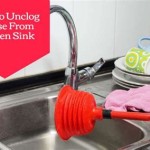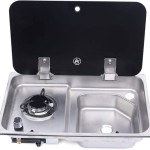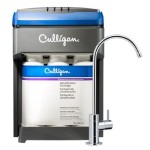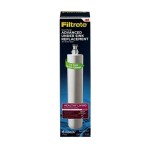Removing Rust Stains from Sinks: A Comprehensive Guide
Rust stains in sinks are a common household problem, often detracting from the overall cleanliness and aesthetic appeal of the bathroom or kitchen. These stains, typically brown or reddish-orange in color, are the result of iron oxidation, a chemical process triggered by exposure to water and oxygen. Understanding the causes of rust formation and employing appropriate cleaning methods are crucial for effectively removing these blemishes and preventing their recurrence.
The presence of iron in water is a primary contributor to rust stains. Water sources, whether municipal or well-based, frequently contain dissolved iron. When this iron-rich water comes into contact with the sink's surface, particularly in areas where water tends to pool or linger, the iron can oxidize, leading to the formation of rust deposits. Faulty plumbing fixtures, such as dripping faucets or corroded pipes, can exacerbate the problem by constantly supplying water and accelerating the oxidation process.
The material composition of the sink itself can also influence its susceptibility to rust staining. While stainless steel sinks are generally more resistant to rust, they are not entirely immune. Scratches or abrasions on the surface of stainless steel can compromise its protective layer, exposing the underlying iron to moisture and increasing the likelihood of rust formation. Porcelain sinks, on the other hand, are porous and can absorb iron-rich water more readily, making them more prone to staining. Cast iron sinks, coated with enamel, can also develop rust stains if the enamel coating is chipped or damaged, exposing the cast iron beneath.
Identifying the type of sink material is a crucial first step in selecting the appropriate rust removal method. Certain cleaning agents that are safe for stainless steel may be abrasive or corrosive to porcelain or enamel surfaces. Likewise, solutions that effectively dissolve rust on porcelain might damage the finish of a stainless steel sink. Therefore, a careful assessment of the sink's material is essential to avoid causing further damage during the cleaning process.
Identifying the Cause of the Rust Stain
Pinpointing the source of the rust stain is essential for preventing its recurrence. It involves examining the water source, plumbing fixtures, and surrounding environment. If the rust stains are persistent and widespread, a water test can determine the iron content of the water supply. This information can help in selecting a suitable water filtration system or water softener to reduce the iron levels and prevent future staining. If the rust stains are localized around a specific faucet or drain, inspecting these fixtures for leaks or corrosion is necessary. Replacing faulty or corroded plumbing components can eliminate a major source of iron and water, thereby minimizing the risk of rust formation.
Additionally, consider the items placed in or around the sink. Metal objects, such as razors, shaving cream cans, or cleaning supplies, can leave rust stains if they come into prolonged contact with the sink's surface, particularly when wet. Storing these items in a dry location or using a protective barrier can prevent them from contributing to rust staining. Regular cleaning of the sink itself can also help to remove any accumulated iron deposits before they have a chance to oxidize and form stubborn stains.
Furthermore, the use of certain cleaning products can contribute to rust staining. Abrasive cleaners or scouring pads can scratch the sink's surface, creating microscopic crevices where iron-rich water can collect and oxidize. Acidic cleaners, while effective at removing some types of stains, can also corrode the metal components of the sink and its surrounding fixtures, leading to the release of iron and the formation of rust. Therefore, selecting cleaning products that are specifically formulated for the sink's material and avoiding harsh abrasives or acids is crucial for maintaining its integrity and preventing rust staining.
Effective Cleaning Methods for Rust Stain Removal
Several methods can be employed to remove rust stains from sinks, ranging from readily available household ingredients to commercially available rust removers. The choice of method should depend on the severity of the stain, the type of sink material, and personal preference.
For mild rust stains, a paste made from baking soda and water can be effective. Baking soda is a mild abrasive that can help to lift the rust deposits from the sink's surface without causing damage. Simply mix baking soda with water until a thick paste is formed, apply the paste to the rust stain, and let it sit for 15-20 minutes. Then, gently scrub the area with a soft cloth or sponge and rinse thoroughly with water. This method is particularly suitable for porcelain and enamel sinks, as it is less likely to scratch or damage the finish.
Lemon juice or vinegar can also be used to remove rust stains. These acidic substances can dissolve the iron oxide that forms rust. Simply apply lemon juice or vinegar directly to the rust stain and let it sit for 30 minutes to an hour. Then, scrub the area with a soft cloth or sponge and rinse thoroughly with water. It is important to note that vinegar can be corrosive to some metal surfaces, so it should be used with caution on stainless steel sinks. Diluting the vinegar with water can help to minimize the risk of damage.
Cream of tartar, a common baking ingredient, can also be used as a rust remover. Mix cream of tartar with water to form a paste, apply the paste to the rust stain, and let it sit for 30 minutes. Then, scrub the area with a soft cloth or sponge and rinse thoroughly with water. Cream of tartar is a gentle abrasive that is suitable for most sink materials.
For more stubborn rust stains, commercially available rust removers may be necessary. These products typically contain stronger acids or chelating agents that can effectively dissolve rust. When using commercial rust removers, it is important to follow the manufacturer's instructions carefully and to wear gloves and eye protection to avoid skin or eye irritation. It is also advisable to test the product on a small, inconspicuous area of the sink before applying it to the entire stain to ensure that it does not damage the finish.
Preventative Measures to Avoid Rust Stains
Preventing rust stains from forming in the first place is the most effective approach to maintaining the cleanliness and appearance of sinks. Implementing several preventative measures can significantly reduce the likelihood of rust staining.
Regularly cleaning the sink is essential. Wipe down the sink after each use to remove any water droplets or spills that could contribute to rust formation. Use a non-abrasive cleaner and a soft cloth or sponge to avoid scratching the surface. Periodically deep-cleaning the sink with a mild cleaning solution can help to remove any accumulated iron deposits before they have a chance to oxidize.
Addressing plumbing issues promptly is crucial. Repair any leaky faucets or pipes to prevent water from constantly dripping onto the sink's surface. Replace corroded plumbing fixtures to eliminate a source of iron that can contribute to rust staining. Consider installing a water filtration system or water softener if the water supply contains high levels of iron.
Protecting the sink's surface is also important. Avoid using abrasive cleaners or scouring pads that can scratch the surface. Use a sink grid or mat to protect the bottom of the sink from scratches and to prevent metal objects from coming into direct contact with the surface. Store metal objects in a dry location away from the sink to prevent them from leaching iron onto the surface.
Furthermore, maintaining proper ventilation in the bathroom or kitchen can help to reduce humidity levels and prevent moisture from accumulating on the sink's surface. This can help to slow down the oxidation process and reduce the likelihood of rust formation.
By understanding the causes of rust stains, employing appropriate cleaning methods, and implementing preventative measures, homeowners can effectively remove existing rust stains and prevent their recurrence, ensuring that their sinks remain clean and aesthetically pleasing for years to come.

How To Remove Rust Stains From Toilets Tubs And Sinks

Rust In Your Stainless Steel Sink Duncan S Creative Kitchens

How To Remove Rust Stains From A Porcelain Tub Or Sink Cabana State Of Mind

How To Remove Rust Stains From Sink Tub Mr Handyman

How To Remove Rust Stains From A Porcelain Sink

Removing A Rust Stain From Sink Youtube

How To Get Rid Of Iron And Rust Stains Once For All Water Right

Get Rid Of Sink And Bathtub Rust Stains

Ty D Bol Rust Remover Sink And Toilet Bowl Cleaner Liquid 16 Fl Oz

Top 5 Ways To Get Rust Stains Out Of Sinks Toilets Snell Heating Air







